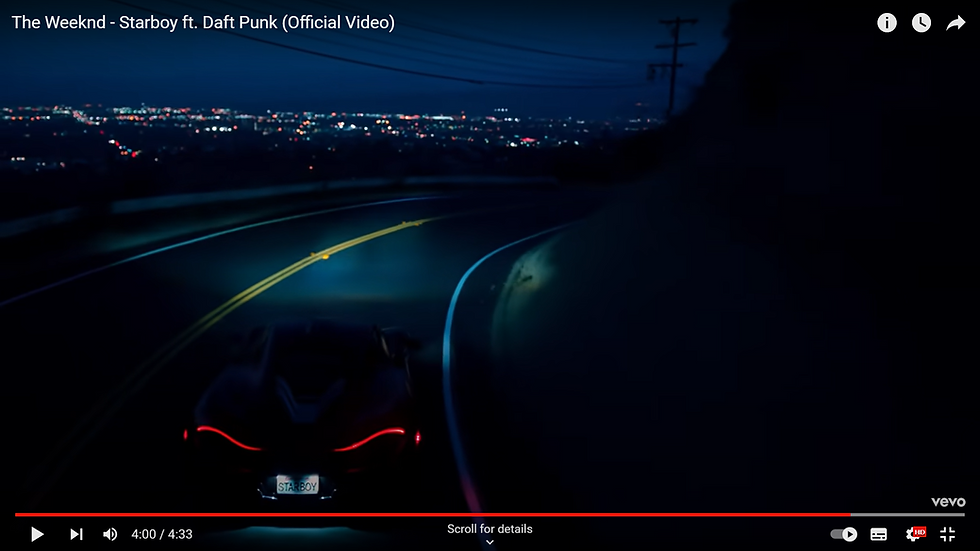Research into Camera Techniques for a Music Video
- mahnoor rashid khan
- Aug 8, 2022
- 4 min read

Camera Shots:
Numerous shots are used in music videos for a variety of purposes, including to show the spectator what is happening as well as to connect with the audience by sharing thoughts and feelings. The following camera angles would appear in a music video:

Long Shot - In a long shot, the complete subject is visible from head to toe and the subject is positioned in relation to their surroundings. The long shot, commonly referred to as a "broad shot" or "full shot," is employed to depict the interaction between characters and their surroundings.

Mid Shot - In film and television, a medium shot—also known as a waist shot or a mid-shot—is a style of camera shot that displays the subject from the waist up. By giving the character and their surroundings equal room in the frame, medium shots draw attention to both.

Medium Close-up - A medium close-up, or MCU, frames the subject in cinematography from just above the head to just below the chest. The medium close-up is a neutral view that captures the subject's body language and facial expression while also including some of the background.

Close-up Shot - A close-up shot is a type of camera angle used in filmmaking and photography to capture a person or object from head to toe. The close-up lens has the effect of making the subject appear more prominent, large, or important than they are in reality.

Extreme Close-up - A movie or television camera angle known as a "extreme close-up shot" places the lens just centimetres away from the face of an actor. This provides a closer look at the actor's facial expressions and feelings for the audience, which can be used to build suspense.

Over the shoulder shot - The OTS shot is employed to show the viewpoint of the person whose shoulder the camera is behind. This strategy is frequently used to influence how much the viewer identifies with a character or to show the dynamics of a connection between two characters.
Camera Angles:
The angle of the shot is determined by where the camera is placed. Music videos are produced using a variety of camera angles to communicate various messages. Instances of camera angles include:

Eye- level angle - a shot in which the camera is level with the character or individuals being filmed. Its purpose is to provide the audience with a very familiar perspective rather than to distort or over-dramatize a subject, making it a "neutral" camera angle.

High Angle - In a high angle view, the subject is filmed from above as the camera looks down on it. Someone or anything appears smaller when viewed from a higher vantage point.

Low Angle - Any shot that is taken from a camera angle that is low on the vertical axis and facing up, or at any angle below the average eye line, is referred to as a low angle shot.

Birds Eye View - When the camera is directly above the subject, it is said to be taking an overhead shot. It is positioned at about a 90-degree angle above the action. A bird perspective, bird's eye view, or elevated shot are other names for overhead shots.
Camera Movements:
To follow the artist or to capture the artist in action, the camera pans. These motions involve tracking and panning. A director may elect to advance the action by cutting from one shot to the next or they may decide to move the camera along with the action. Here are a few instances of camera movements:
Pans - The camera horizontally scans a scene when it pans. When the camera is pivoted, frequently to follow a moving object that is retained in the centre of the picture, it is mounted on a tripod, which serves as a stationary axis point.
Dolly/Tracking - For a particularly smooth movement, the camera is attached on a cart that slides along tracks. often referred to as tracking This is done to highlight motion.
Tilt - Similar to pans, but vertical, are camera tilts. A camera can be pointed upward or downward by tilting the camera. A character can be given the starring role in a shot or new information can be revealed to the audience by using camera tilts. Filmmakers can use tilts to capture the verticality of a scene during awe-inspiring or spectacular moments.
Push in - With a dolly camera movement or Steadicam, a push-in brings the camera up close to the subject. Push-ins can direct the audience's focus to a certain aspect. Additionally, filmmakers approach characters closely to attempt and deduce what is happening inwardly. This could be a response, a train of thought, or an internal struggle.
Push out - The push in of the camera is exactly the opposite of the pull out. When the camera pulls out, it does so smoothly and moves farther away from the subject. The individual shrinks as a result of this motion, which also makes their surroundings visible.
Zoom - Despite the fact that zooms aren't technically camera movements, they do cause movement in the picture. Zooms allow you to enlarge or reduce the size of a subject in the picture by altering the focal length of a camera lens.
Boom shot - Moviemakers use the boom shot to move the camera up or down vertically. Jibs, pedestal camera motions, and boom crane camera movements are used to create boom shots. Small boom motions like these are frequently utilised for character and reveal revelation.
Music video used as a reference above:


Comments